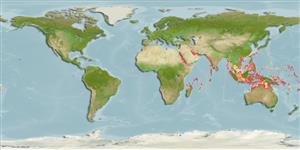>
Gobiiformes (Gobies) >
Gobiidae (Gobies) > Gobiinae
Eponymy: Charlotte ‘Lotte’ Hildregard Hass née Baierl (1928–2015) was an Austrian diver, model and actress. [...] (Ref. 128868), visit book page.
Environment: milieu / climate zone / Tiefenbereich / distribution range
Ökologie
seewasser riff-verbunden; tiefenbereich 10 - 15 m (Ref. 90832). Tropical; 22°C - 26°C (Ref. 27115); 30°N - 18°S
Western Indian Ocean: Red Sea and adjacent areas. Elsewhere in the Indo-West Pacific refers to Lotilia klausewitzi.
Size / Gewicht / Alter
Geschlechtsreife: Lm ? range ? - ? cm
Max length : 3.1 cm SL Männchen/unbestimmt; (Ref. 90832)
Kurzbeschreibung
Bestimmungsschlüssel | Morphologie | Morphometrie
Rückenflossenstacheln (insgesamt) : 7; Rückenflossenweichstrahlen (insgesamt) : 9; Afterflossenstacheln: 1 - 9; Afterflossenweichstrahlen: 9; Wirbelzahl: 26. This species is distinguished by the following characters: no cephalic sensory canals and pores; sensory-papillae row 4i not extending ventrally beyond a horizontal line through posterior end of row d; right and left sides of row n are not close to one another, with a broad interspace between them; branched caudal-fin rays 7+7=14; pale area on dorsum from snout to dorsoanterior part of body is relatively long, extending posteriorly to around base of third or fourth spine; presence of a conspicuous ocellated black spot with vivid pale margin at center of first dorsal fin, extending anteriorly beyond third spine; absence of a submarginal row of black spots on caudal fin (Ref. 90832).
Cross section: compressed.
Found only on sandy areas, and symbiotically associates with a snapping shrimp, probably Alpheus djiboutensis where it swims freely at ca. 10-15 cm above the nest hole as it moves its pectoral fins alternately. It was also reported that, in the northern Red Sea, it is associated with an unidentified Alpheus species which is not A. djiboutensis (Ref. 90832).
Life cycle and mating behavior
Geschlechtsreife | Fortpflanzung | Ablaichen | Eier | Fecundity | Larven
Shibukawa, K., T. Suzuki and H. Senou, 2012. Review of the shrimp-associated goby genus Lotilia (Actinopterygii: Perciformes: Gobiidae), with description of a new species from the West Pacific. Zootaxa 3362:54-64. (Ref. 90832)
IUCN Rote Liste Status (Ref. 130435: Version 2025-1)
Bedrohung für Menschen
Harmless
Nutzung durch Menschen
Fischereien: kommerziell; Aquarium: Kommerziell
Tools
Zusatzinformationen
Download XML
Internet Quellen
Estimates based on models
Preferred temperature (Ref.
123201): 25.3 - 29.1, mean 28.1 °C (based on 488 cells).
Phylogenetic diversity index (Ref.
82804): PD
50 = 0.7500 [Uniqueness, from 0.5 = low to 2.0 = high].
Bayesian length-weight: a=0.00724 (0.00339 - 0.01546), b=3.10 (2.92 - 3.28), in cm total length, based on LWR estimates for this (Sub)family-body shape (Ref.
93245).
Trophic level (Ref.
69278): 3.1 ±0.3 se; based on size and trophs of closest relatives
Widerstandsfähigkeit (Ref.
120179): hoch, Verdopplung der Population dauert weniger als 15 Monate. (Preliminary K or Fecundity.).
Fishing Vulnerability (Ref.
59153): Low vulnerability (10 of 100).
🛈
Nutrients (Ref.
124155): Calcium = 238 [101, 517] mg/100g; Iron = 1.04 [0.49, 2.11] mg/100g; Protein = 17.7 [15.7, 19.5] %; Omega3 = 0.106 [0.042, 0.228] g/100g; Selenium = 27.4 [10.9, 69.2] μg/100g; VitaminA = 147 [37, 574] μg/100g; Zinc = 2.86 [1.75, 4.42] mg/100g (wet weight);
